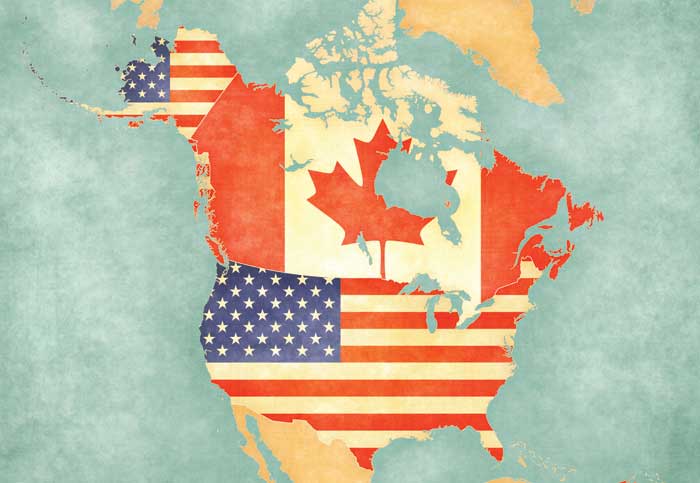CALPA–ALPA MERGER +20: Growing Stronger in Canada
By Christopher Freeze, Senior Aviation Technical Writer

February 1 marks the 20th anniversary of the merger between the Canadian Air Line Pilots Association (CALPA) and ALPA, which at the time brought 10 pilot groups and 2,700 Canadian pilots into the Association—making ALPA more than 43,000 pilots strong in 1997.
“By Canadian pilots being a part of ALPA, we have access to a vast arsenal of tools and resources, the most talented negotiations team in the industry, and access to subject-matter experts and professional staff with aeromedical, legal, safety and security, communications, and member service expertise,” said Capt. Dan Adamus (Jazz Aviation), ALPA’s Canada Board president.
Since 1997, pilots from Air Transat, Canadian North, First Air, and Wasaya have joined the Association, while five of the original pilot groups have merged into Jazz Aviation (see “The Original 10”). Today, ALPA represents approximately 2,500 Canadian pilots from eight airlines.
“While we’ve been prioritizing our organizing in the U.S. and Canada, with recent campaigns at WestJet and Air Georgian Limited, our pilot union is stronger with every pilot voice we add and every collective agreement we negotiate,” said Capt. Tim Canoll, ALPA’s president. “We’re strategically moving forward our organizing efforts and advancing the future of our profession.”
Capt. Randy Babbitt, ALPA’s president at the time of the merger, borrowed from John F. Kennedy when summing up the merger: “‘Geography has made us neighbors.… History has made us friends. Economics has made us partners, and necessity has made us allies.’ Necessity must make us allies at this point in the history of U.S. and Canadian pilots.”
And with the addition of its Canadian members, ALPA has become stronger in voice and action—recognized as the preeminent pilots’ union in the world (see “Pilot Commentary”).
CALPA–ALPA Merger Timeline
With help from ALPA, the Canadian Air Line Pilots Association (CALPA) was founded in 1937 to represent the pilots of Trans-Canada Airlines, the forerunner of Air Canada. Together, with British ALPA, these organizations cofounded the International Federation of Air Line Pilots’ Associations (IFALPA) in 1948.
January 1994—ALPA’s Executive Council authorizes the creation of an ALPA/CALPA Joint Study Committee, composed of representatives from both organizations, to pursue development of a services agreement.
January 1995—The ALPA/CALPA Administrative Services Agreement allows CALPA access to ALPA staff resources for specific projects on a fee-for-service basis. It also allows for bilateral attendance and speaking privileges at the two organizations’ respective meetings, observer status at governing body meetings, and joint media and negotiating training seminars.
January 1996—The service agreement ends, and an ALPA/CALPA Steering Committee, with the mission of studying future action—including the possibility of a merger—is established. The committee is led by Capt. Rob McInnis (Canadian), who later said, “Neither CALPA nor ALPA is a headquarters building or a logo or a banner; rather, they are people committed to pilots’ interests, goals, and well-being.”
October 1996—At the Association’s Board of Directors meeting, ALPA pilots vote unanimously for a merger with CALPA. Capt. Duane Woerth, ALPA’s first vice president and IFALPA director, states, “The relationship that we’re forging with the pilots from Canada is an initial signal that the world’s pilots will meet the challenges of globalization together, creating better careers for ourselves and our families in the worldwide marketplace.”
November 1996—At CALPA’s Convention Assembly, CALPA pilots vote unanimously for the merger between CALPA and ALPA, and the official merger process begins.
Jan. 10, 1997—Eighty-nine percent of CALPA pilots vote in favor of the merger, an overwhelming mandate to set the merger in motion.
Feb. 1, 1997—The merger is officially complete. McInnis, then-IFALPA president, applauds the new entity’s strength in unity, stating: “Governments and aviation authorities, as well as aviation companies, are blurring national boundaries through harmonization, liberalization, privation, equity investments, and cross-borders alliance. Our challenge is to ensure pilot representation is equally forward-looking and able to meet and surpass coming challenges.”
“The Original 10” of CALPA
Air Alliance
Air BC
Air Nova
Air Ontario
Bearskin Airlines
Calm Air International
Canadian Airlines International
Canadian Regional Airlines
Kelowna Flightcraft
Northwest Territory Airways

